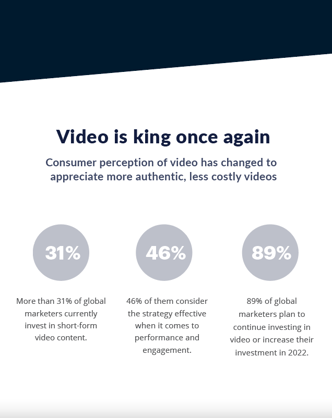The secret to creating quality content for digital marketing
Video may have killed the radio star decades ago, but as digital transformation has accelerated across industries, consumers have changed the ways they evaluate and purchase solutions, and video has become an even more compelling tool for marketing. Historically, video has often been out of reach for small marketing budgets. But now, as consumers have shifted their behaviors during the global pandemic and more people are creating video on their phones, consumer perception of video has changed to appreciate more authentic, less costly videos.
Did you know …
- More than 31% of global marketers currently invest in short-form video content.
- 46% of them consider the strategy effective when it comes to performance and engagement.
- 89% of global marketers plan to continue investing in video or increase their investment in 2022.
(Source: The Marketing Trends of 2022 [New Data] | Hubspot)
Already within the space of this blog’s intro, I’ve shared enough content to create:
- One blog intro
- Three static social media banners
- Three motion graphics
- One infographic

Why reuse, repurpose, and reframe content?
The average person spends 13.5 hours scrolling social media every day. They see around 10,000 ads a day. And on average, it takes exposure to your brand 6–8 times before a user will click to learn more about your solution. Just to get a viewer to click on your content in the overwhelming sea of content the viewer is consuming, your content must be visually and intellectually compelling. It must capture your audience’s attention and elicit a click. But what happens when they click?
By the time a user clicks, they are interested in your content, so if they’re ready to learn more, they are looking for unique, differentiated content to help them along in their buying journey. They want to self-educate before engaging with your company. They want to learn as much as they can before giving you their name or contact information. So, making educational materials freely available is critical to your digital marketing and sales strategy.
If the average user needs to see 6–8 ads to pique their interest enough to click to learn more, you will need at least 13 different deliverables per buyer persona. And once they click, you’ll need to provide educational content in various formats to resonate with your audience. Are they visual learners? Do they prefer to read or watch a video? Are they auditory? You can reposition the same content in various formats to resonate with the learning styles of different audience members.
Where are they in their buying journey? Are they just starting to explore solutions like yours? Or have they already done some research and now they’d like to understand your competitive differentiators? Do they want to see a case study? Are they ready to compare features and functionality? Do they want a ballpark price before speaking to a seller? It depends on where they are in their buying journey, and you will have no way of knowing when a user lands on your site what stage they are in. Did they receive a referral from a friend? Do they have any context? You don’t know. So, you need to provide multiple pieces of content to address every stage of the buyer’s journey – giving your buyers the power to self-educate and explore at their own pace.
Invest wisely
Let me be clear – as a content creator myself and the owner of a creative agency – creating enough content to keep up with your audience’s voracious rate of content consumption is time consuming and expensive. Yes, you will need to invest in some strategic pieces of content – industry research, a white paper, and case studies. But once you have those deliverables, you have what you need to extract stats, quotes, best practices, and core messaging, which can all be used to create digital marketing materials for a robust campaign to meet your buyers where they are in their journey.
For buyers just starting their journey, a few stats can turn into multiple ads, as illustrated in the intro of this blog. A single industry research paper can be leveraged to write multiple blogs or create short (15–30 second) soundbite videos with key trends and proof points. Once your audience engages, they want to understand how your solution is going to solve their business pains. Leverage the same source materials to create a short, visual, engaging eBook or infographic.
If your buyer is still interested, they’ll be looking for deeper educational content like the white paper you’ve invested in, and once they are ready to make a buying decision, they’ll want to know that your solution works for other users like themselves. This is where case studies come in. Case studies can be included in multiple pieces of content and delivered in written or video form. Regardless of how you repackage your core content, investing wisely in a few materials will give you the opportunity to stretch your investment into great impact.
Add value
Remember that your target audience is viewing an overwhelming amount of content daily, and if they’re really researching a solution like yours, your competitors are also creating a ton of similar content. So, it is important that you position your content in a way that adds value to your target customers. Help them understand not just what is happening in the industry and how many features and functions your product or service addresses. Go beyond that to help them understand how you are going to solve their unique business pains so they can achieve their goals, eliminate stress, and feel confident in your offering.

In a saturated digital market, it’s imperative that you not just create a high volume of content, but also that you generate high value content. If you can provide a tool to help your target audience calculate cost savings or even an infographic or motion graphic that illustrates their potential cost savings or time efficiency, you will make your benefits memorable and “sticky” so that, as your audience continues to scroll social media for the rest of the day, they’ll keep returning to your content as it resonates in their minds repeatedly.
Pay attention
The beauty of digital marketing is that you can adjust in real time. Unlike an expensive billboard on the side of the freeway, you can change the colors or headline on a banner in a manner of minutes. Pay close attention to your metrics – which ads perform better than others? Is it their placement on the page? Is it the color? Is the message witty? Is there a particular audience that is clicking some ads more often than others? Learn as you go. Gather metrics from your digital campaigns and adjust your existing content to accommodate your findings. Change your banner colors, text, placement, target; reuse the same banners but reframe the content to drive more clicks. Use the tools at your disposal to reposition your existing content to reach a broader or more targeted audience.
Don’t just keep up – get ahead!
Digital marketing is a rapidly evolving practice. There are new platforms emerging daily, and consumer behavior changes often. But one thing remains constant: the need for quality content at scale. Multiple formats on multiple platforms targeting multiple personas. Taking the time to create strategic source materials that can be reused, repurposed, and reframed will help you accelerate your marketing campaigns and outpace your competition.
Let us know if you’d like some help thinking through your content strategy.

